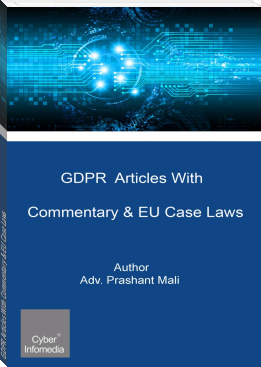Flare: Opinions (Law, Human Rights and Politics), Ankur Mutreja [easy books to read in english TXT] 📗

- Author: Ankur Mutreja
Book online «Flare: Opinions (Law, Human Rights and Politics), Ankur Mutreja [easy books to read in english TXT] 📗». Author Ankur Mutreja
FLARE | OPINIONS (LAW, HUMAN RIGHTS AND POLITICS)
First Edition, 2015
Ankur Mutreja
(ankurmutreja.com)
Copyright © 2015 Ankur Mutreja
Introduction
Opinions are like flare, which can turn either way: they can spread like wild fire or encapsulate themselves within the bounds of personal integrity, and thus illuminate. I started writing opinions in the late 2008 through my blogs. I admit at times I did go wild with unsubstantiated accusations and surmises, leading to risky speculations and irresponsible opinions. Recently, I published a comprehensive book of my writings entitled “Writings @ Ankur Mutreja”, and the present book is a short selection of my opinions presented therein with emphasis on responsible writing.
I am an advocate by profession; therefore, most of my opinions have a tint of law; in the first part, the expression is simple; so, it is for lay persons who won’t mind a little exercise of mind in the legal arena; whereas, in the second part, I have gone whole hog with law, and I admit those without formal legal training may find it convenient to ignore.
My style of writing is terse and pointed, but at times I have gone overboard like in one particular opinion on Aarushi murder, where emotions and logic intermingled in an expanded narrative. Rights, especially privacy and equality, are my area of focus; therefore most of my opinions herein; i.e., the ones discussing Brain Research, NCTC, Sting Operations, LGBTs, Prostitution, SC/ST quotas, and AADHAR/NPR; are focused on these two areas.
In my selection, I have tried steering clear of politics, but politics is nevertheless all encompassing; however, one opinion on tussle between Delhi Police and AAP is majorily political; another political opinion, but with a strong emphasis on law, is the discussion of Zakia Jaffrey case.
There were few very big events in the recent past; one amongst them is the Nirbhaya murder, and I have also discussed it, though my take is slightly different: I think the murder has been manipulated by the vested interests.
I am a resident of an unauthorized colony; therefore, my opinion on Unauthorized Colonies has found place in the present selection; though I admit had the case been different, I wouldn’t have included it; so please bear with my little bias.
Though I have no expertise in international affairs, I have taken a plunge into it albeit within the ambit of my legal training; the topics discussed are Indo-Pak relationship and Julian Assange.
Finally, in the second part, I have discussed various judgments and laws. I would recommend anybody to read at least my critique of Aarushi Judgement. Other than that I have critiqued Binayak Sen Judgement and Aruna Shaunbaug Judgement. In the second part, I have also critiqued RTI Act and Amendments in IPC post Nirbhaya murder.
Enjoy Reading! Ankur Mutreja.
Note: This book was published in July 2015, but I have added a comment dt. 25.09.2015 in the Chapter: Aarushi Murder Case Judgment: A Critique – an advantage of Indie Authorship.
Chapter 1: Opinions (General)
Chapter 1.1: The Danger of Brain Research
(March 2014)
Brain research is a fledgling area. The documented objectives of the research include understanding the complex working of the brain for medicinal, surgical and artificial intelligence purposes. The undocumented objectives include mind control, especially for the purpose of “intelligence and security”; the surreptitious research in this area has already advanced quite a lot mainly because of the use of innovative engineering techniques involving wave physics and computer modeling. According to the conspiracy theorists, it is now possible to read the thoughts of a person, with or without bugging the brain or any other part of the body. In fact, the research carried out after bugging the brain is well documented, and the visual and vocal images originating from the brain of the guinea pigs have been transferred to LCD screens and speakers respectively – this means that what a person speaks to himself can be heard, and what he dreams in his mind in the form of images can be seen.
Now let us see where the research is headed. The documented research till now has been able to demarcate the areas of brain responsible for various activities like smell, language, visual images, etc. They also know that the brain activities take place in the form of electrical impulses. The brain emits waves of low frequency, which can be read by proper modulation, and that is how the vocal and visual images are read. However, the complex processes of brain and/or nervous system, like consciousness, are yet unknown. In fact, there are certain quantum physicists who believe that consciousness is not a neuron function at all, but a microtubules function, and is thus inherently unpredictable in accordance with the laws of quantum physics, and thus artificial intelligence is impossible. Nevertheless, even if it is assumed that the current research is headed in the right direction, and, by researching the neural interconnections, one can unravel the mysteries of the brain, this task is next to impossible because the number of interconnections between the nerves in a human brain are more than the number of atoms in the universe — just imagine how daunting a task it is. Then, why should the corporate and the governments throw so much money into this field?
The answer lies in the undocumented mind control research. They all know they are never going to achieve anything in the field of artificial intelligence, and the benefits in the field of surgery may also not arrive in the concrete form ever. However, the benefits in the field of mind control are enormous. If the conspiracy theorists are to be believed, there are tools and techniques through which any human brain can be read using wave technology; so, what is required is the strategic location (say in a police station) of the right machines, tools and implements in the residential neighborhoods in densely populated cities; now combine this with the organized harassment through the politicians and the police agents: well, one can potentially control each single mind. The USA has, in the past, carried out extensive research on this aspect and also executed the same under the codename “Cointelpro”, wherein the black rights activists were targeted by the State through organized stalking and electronic harassment. The USA has officially shelved this program, but, if the conspiracy theorists are to be believed, the program has been institutionalized across the globe for targeting prospective rebels and rebellion. However, the more distressing is the prospect of direct penetration of minds using the Nanobots; the Nanobots are microscopic robots invisible to human eyes and, when diffused in the air, can be inhaled. Logical extrapolation makes me believe that the objective of the future brain research will be to unravel as many mysteries of the brain as would be necessary to effectively employ Nanobots for controlling the human mind through computer commands: This would be an alternative way of achieving artificial intelligence by converting humans themselves into robots.
I don’t know whether the above objective is achievable, but look at the prospects of human right violations even if such a research is carried out, and we never know what other methods of mind control may be under contemplation or discovered. Last but not the least, what about the unwilling guinea pigs, who are left no more than zombies?
Chapter 1.2: Legalising Prostitution
(November 2014)
As per the Immoral Trafficking (Prevention) Act, 1956, of India, prostitution means “the sexual exploitation or abuse of persons for commercial purposes or for consideration in money or in any other kind, and the expression ‘prostitute’ shall be construed accordingly.” However, it is to be noted that the Act doesn’t criminalize prostitution per se; it only criminalizes certain instances of prostitution; it criminalizes prostitution in brothels; i.e., any place where two or more prostitutes practice their trade or a single prostitute practices her trade for the gain of another person, not for her own gain; it criminalizes living on the earnings of a prostitute with a rebutable presumption that any adult habitually in the company of a prostitute is living on her earnings; it criminalizes prostitution in vicinity of a public place; it criminalizes soliciting clients in a public place; and it obviously criminalizes all kinds of trafficking, explicit or implicit, for the purpose of prostitution; however, the most controversial provision is the one providing for removal of prostitutes from any place, whatsoever, by a DM/SDM/Executive Magistrate within his local jurisdiction in General Public Interest — it is to be noted that police officers are often given the powers of executive magistrates.
From the above, it clearly emerges that prostitutes, irrespective of their mode of practice, are considered as out-castes. They are not allowed to associate with the community at large as of right, and, even in the cases of individual interactions, there is hardly any chance for them to interact with the people other than those from their own profession, for anybody seen habitually with a prostitute runs the risk of being called her parasite and thus a criminal; they also can’t form partnerships or solicit clients freely, thus restricting their practice of their profession.
It seems there are already talks to amend the Act. In 2006 as well, a bill was introduced but it lapsed (Re: http://www.prsindia.org/billtrack/the-immoral-traffic-prevention-amendment-bill-2006-143/). The bill deleted the provisions putting restrictions on soliciting clients and providing for removal of prostitutes.
I think Section 20 of the Act providing for removal of prostitutes is extremely derogatory. A prostitute without being termed a criminal is, nevertheless, being treated like one. She is being left at the mercy of the community to be accepted as a regular resident/citizen, which, more often than not, is denied; and, thus, the prostitutes tend to congregate and live their limited existence in ghettos like G. B. Road, Sonagachi, Kamathipura, etc.; and then the community conveniently designate these areas as “red-light” areas — or, should we say the law regularized the derogatory practice of the society? So, the amendment deleting this provision was certainly welcome.
However, the other amendment deleting Section 8 of the Act providing for restrictions on soliciting clients in a public place was not welcome. The solicitation of clients for the purpose of prostitution would obviously not be decent because the society doesn’t consider sex per se to be a decent activity, which, in a way, is also correct — if ever, only nuns and popes would enter into disciplined decent acts; the rest would do sex passionately and wildly. So, the solicitation of clients for paid sex would naturally tend to be indecent: Who will ever go to a prostitute wearing black robe with wide collars? I would say the solicitation of clients by prostitutes is a tricky issue; some kind of official list of prostitutes with contact details for further private communication displayed at public places, is the best way to advertise prostitution.
However, I think the pro-prostitution proponents want greater freedom for prostitutes in the practice of their profession: They would like them to form partnerships, appoint pimps and managers, and even open licensed brothels. There are certainly some very ulterior motives involved in all this. There are people who don’t only want to





Comments (0)